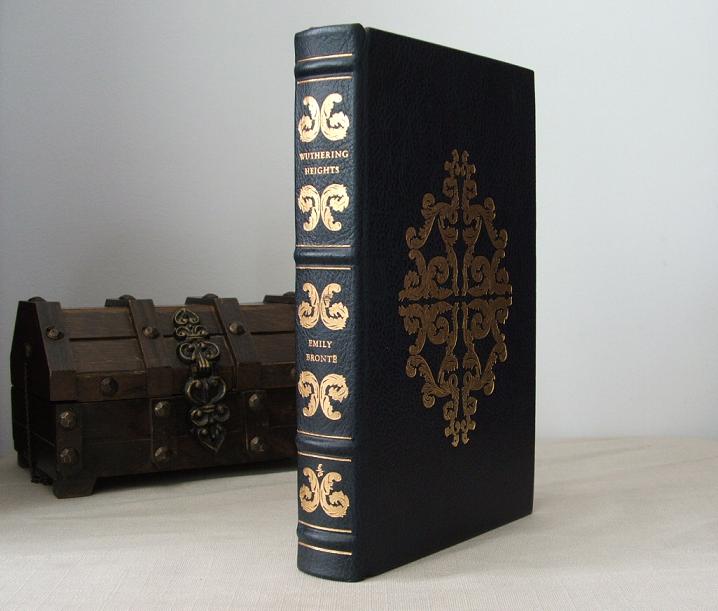Easton Press Emily Brontë books
Wuthering Heights - 100 Greatest Books Ever Written - 1980
Franklin Library Emily Brontë books
Wuthering Heights - 100 Greatest Books of All Time - 1975
Wuthering Heights - World's Best Loved Books - 1978
Wuthering Heights - Oxford Library of The World's Greatest Books - 1984
Who was Emily Brontë?
Emily Brontë, born on July 30, 1818, in Thornton, West Yorkshire, England, was a gifted English novelist and poet, best known for her only novel, Wuthering Heights. She is one of the celebrated Brontë sisters, alongside Charlotte and Anne, all of whom made significant contributions to English literature in the 19th century. Growing up in the Yorkshire moors with her siblings, Emily Brontë developed a deep connection to the landscape, which later played a crucial role in her literary works. The Brontë family's imaginative and isolated upbringing contributed to the creation of a rich imaginary world, Gondal, which served as a foundation for the sisters' early literary endeavors.In 1847, Emily published Wuthering Heights under the pseudonym Ellis Bell. The novel is a dark and passionate tale of love, revenge, and the destructive power of societal expectations. While Wuthering Heights was met with mixed reviews initially, it has since become a classic of English literature, admired for its complex characters and innovative narrative structure. Emily Brontë's writing is characterized by its intense emotional depth and exploration of the human psyche. Her work often delves into the darker aspects of human nature, and "Wuthering Heights" stands as a testament to her ability to create hauntingly unforgettable characters and settings.
Emily Brontë poems
Known primarily for her novel Wuthering Heights, Emily Brontë also wrote poetry. Her poems, often characterized by their intense emotion, connection to nature, and exploration of the human spirit, are part of a collection published posthumously by her sister Charlotte Brontë. Emily Brontë peoms include: Love and Friendship - This poem explores the themes of love and friendship, and it reflects Brontë's complex views on these relationships. Remembrance - A poignant and melancholic poem that reflects on the themes of memory and loss. The Night-Wind - This atmospheric poem captures the mysterious and untamed aspects of nature, echoing Brontë's connection to the Yorkshire moors. Hope - In Hope, Brontë delves into the idea of hope as both a source of comfort and a torment, emphasizing the emotional turmoil within the speaker. Spellbound - Spellbound explores themes of enchantment and captivity, drawing on the imagery of a spell and the impact it has on the speaker.It's important to note that Emily Brontë's poetry is not as extensive as her sister Charlotte's or some other poets of the time. However, her poems, like her novel "Wuthering Heights," are revered for their emotional depth and the atmospheric, almost mystical quality that characterizes her writing.
How did Emily Brontë die?
Tragically, Emily Brontë's life was cut short at the age of 30 when she succumbed to tuberculosis on December 19, 1848. Her literary legacy, however, endures through the enduring popularity and critical acclaim of "Wuthering Heights." Despite her relatively brief literary career, Emily Brontë is remembered as a literary genius whose contributions have left an indelible mark on the landscape of English literature.
The novels of Charlotte and Emily Brontë are remarkable for their insight into character, and for the frankness with which they depicted the passions of their heroines, at a time when Victorian traditions in England dictated that women be portrayed as gentle creatures who lived conventional and passionless lives. Emily Brontë was also a poet of distinction. Her Old Stoic (contained in Poems) and her Last Lines (published posthumously) are notable contributions to English poetry.
Wuthering Heights
At the centre of this novel is the passionate love between Catherine Earnshaw and Heathcliff recounted with such emotional intensity that a plain tale of the Yorkshire moors acquires the depth and simplicity of ancient tragedy.Marooned overnight in a lonely home on the Yorkshire moors, the effete Lockwood dreams of a wraith locked out in the snow. Gradually he learns the violent history of the house's owner, the fierce, saturnine Heathcliff and the thwarted love that has led him to exact terrible revenge on the two families that have sought to oppose him.
Since its original publication in 1847, Emily Bronte's only novel, whether repelling, captivating or intriguing different generations of readers, has never relaxed its powerful grip on the public, and the figure of the haunted, brutal Heathcliff has become part of Britain's cultural mythology.
Since its original publication in 1847, Emily Bronte's only novel, whether repelling, captivating or intriguing different generations of readers, has never relaxed its powerful grip on the public, and the figure of the haunted, brutal Heathcliff has become part of Britain's cultural mythology.

Comments
Post a Comment
Share your best book review and recommendation